3 Parrots for Pets and Postball as a Pastime
In the region of the American South and the Caribbean Sea, clans were the most common family system. Among Native American tribes of the southeast, clans were mainly matrilineal. This was also the case with the Tainos, who lived in the Caribbean before arrival of Europeans in the late 15th century and early 16th century.
In the Caribbean, male rulers of Taino villages were known as caciques. If a female was the ruler of the village, she was called a cacias. The eldest son of the ruler’s eldest sister traditionally succeeded a Taino leader. This practice made the Taino society primarily patriarchal, but also matrilineal.
During labor, a Southeastern woman often retreated to the privacy of a birthing hut. After the child was born, a ritual cleansing took place. Animal grease was rubbed all over the child’s body and then the infant was placed in a cradleboard. Much of a child’s first year of life would be spent in this cradleboard.
Southeastern women nursed their babies until they were about two years old. They were gentle mothers who did not often resort to physical punishments. More often than not, these wise mothers disciplined their children verbally. Good behavior was promoted through the use of high expectations, wit, and wisdom. through the use of high expectations, wit, and wisdom.
Mothers tried to instill the traits of humility, industriousness, common sense, and cool-headedness in the young women of their families, clans, or tribes. They did this through story telling, by being good role models, and by having their young girls assist them with the family chores.
Women did the planting, tended the gardens, and harvested the crops. Women made clothing for themselves, their husbands, and their children. They also made pottery, tanned animal skins, and wove fine baskets and mats. These skills were all patiently taught to their granddaughters, nieces, and daughters.
Women prepared the meals. Corn chowders, cornbreads, or some other corn dish was a part of almost every family meal. Family meals often featured wild game, such as bear, deer, fish, or turkey. Pumpkins, beans, peas, potatoes, and squash might also accompany such meats.
Taino women wove, made hammocks, cooked, and prepared the cassava. They also attended to their husbands’ hair and painted their bodies according to ceremonial rules. If single, a women went without clothes; if married, she would wear a kind of apron that covered her from her waist to the middle of her legs.
A French explorer and artist named Jacques le Moyne was assigned the task of documenting the lifestyles and homes of the natives of Florida, as well as mapping the terrain. His journals and drawings have become an important historical resource on the Timucua people.
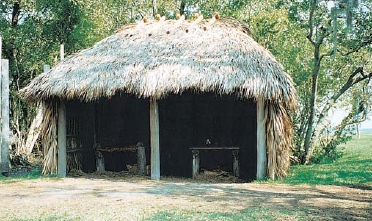
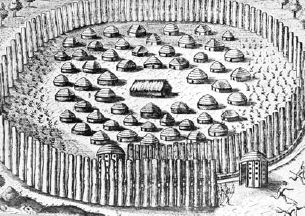
The Timucua and other Indians native to the Florida region lived in houses such as this one made of grass and reeds over a wooden framework. When the first Spanish explorers arrived in the region during the 16th century, they found many Timucua settlements. Some were walled, as in this drawing, to keep out enemy tribes or wild animals.
Men were the family guardians and bravely protected their families and homes. They stood up for the rights of their family, both within their communities and within the world at large. They held the members of their family accountable for poor behavior, but also celebrated the achievements of their wives and children.
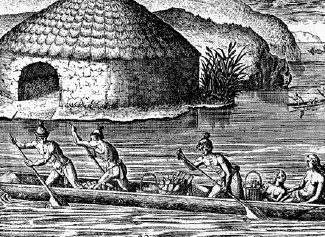
This 16th-century illustration by Jacques LeMoyne shows Taino natives paddling a dugout canoe. To make these canoes, the Taino cut down a large tree and hollowed it by using stone tools as well as careful applications of fire. Men used the canoes to hunt and fish.
The men of the Southeast did the arduous work of clearing the fields so that the women could farm. Creek boys helped women in the gardens until they reached puberty. More often than not, however, men were usually off hunting, fighting, or fishing.
Many Southeastern men were permitted to have more than one wife. A good provider or a wealthy man might have as many wives as he could support. However, his first wife always retained her social status as being the first. Frequently, it was the right of a first wife to approve of or disapprove of her husband’s choice of subsequent wives.
Timucua and other men of the Southeast often tattooed their bodies. A man’s family status and skill as a warrior was often indicated through such tattoos. The Timucua would severely punish a man who tattooed himself with tattoos that reflected a higher status than he had truly earned. The offender was forced to remove the tattoos from his body.
Further south, in the Caribbean, the Taino men wore a breechcloth of cotton or palm fibers cut to a specific length to show rank. This made it easy for other members of his home and village to see his status among them.
The name the Cherokee use for their people is Ani-Yun’Wiya. This means the “main people.” The name “Cherokee” is thought to have come from a word used by the Choctaw to label the Ani-Yun’Wiya as “the people of the land of many caves.”
Large groups of Taino men lived in houses called bohios. One bohio might house from 10 to 15 Taino men, as well as their entire families. It was not uncommon for a Taino bohio to serve as home to up to 100 people.
Taino men cleared the land so that their women could farm it. They hunted, fished, and made wooden dugout canoes. They used their canoes to hunt ducks and sea turtles.
Taino men trained dogs to assist them in their hunts. Taino men were peaceful and engaged in battle primarily only for self defense from the warrior Caribs that raided their villages.
The Carib men were known as fierce warriors. They traveled about the Caribbean, raiding the villages of neighboring communities. They often took prisoners, and it is said that they were cannibals. Male prisoners would be eaten. Female prisoners became the wives or slaves of their captors. Carib men were also expert sailors and fishermen whose dugout canoes were sometimes fitted with sails.
Carib communities traced their relationships through matrilineal kin groups. They did not have chiefs. Carib wives were often women who had been taken from other island communities, like the Tainos, that the Carib had raided.
Children played together for the first few years of their lives. It was not unusual for children under four or five years of age to go without clothing during the warm months of spring and summer. Around five or six, children were expected to begin learning their respective life skills.
Boys learned from their uncles, fathers, and grandfathers. They had close relationships with their maternal uncles, who oversaw their growth from boys to men. Boys were taught how to fish, hunt, and trap. They learned how to make bows and arrows. They carved spears and clubs to be used in battle. They were taught how to clear the land for farming and how to build palisades to protect their villages.
In their spare time, when they weren’t helping their families or their villages, boys learned to do fine carvings and make tobacco pipes and ceremonial drums. A top-quality drum, ornately carved war club, or a first-rate tobacco pipe was a treasured item. Skillful craftsmen who could make these types of items were held in high regard.
Women of the village trained young girls in the arts of weaving, sewing, cooking, courting, marriage, and motherhood. Grandmothers, aunts, and mothers all spoke to the girls about the qualities of a good wife and mother. They talked to the girls about traditional family values, religious beliefs, and acceptable social behavior.
The little girls watched, learned, and helped as their mothers and other women of the tribe made clothing and blankets. They learned to make pottery, sleeping mats and floor mats out of cane, and finely woven grass baskets. The girls were also taught to cook, dry, and store corn and other food staples.
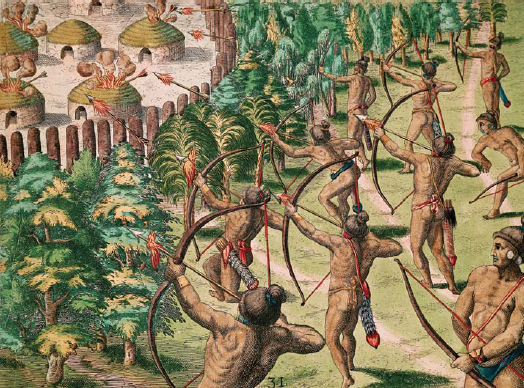
The Caribs were a fierce people that lived in the Caribbean region. They often attacked the villages of other tribes, as this Theodore DeBry illustration of 1570 shows.
For many young women of the Southeast, coming of age meant starting their menstrual cycles. This great milestone in a young girl’s life was marked by a special ceremony. At this time, young girls began to practice a ritual that they would observe monthly, until late in life when they reached menopause. The day their period began, they were separated from the rest of their family and village.
A hut was set aside to house a menstruating woman. She used this time to rest, pray, and meditate. When her period ended, she took a ritual cleansing bath. Afterwards, she would put on clean clothing and return to her family home.
There were many things that a young boy needed to know and do to become a man. His uncles, father, and grandfathers tried to help him understand his place in the family, community, and world at large. Young men in the Southeast were expected, in some tribes, to participate in a battle and prove their skill as warriors before they would be declared men. Other tribes dictated that a young man who wished to marry must build a home and kill a bear or a deer, proving to all that he could be a good provider. The transition from boyhood to manhood was always cause for great family celebration.
Marriage for the Seminoles was a fairly casual relationship. If a man wanted to divorce his wife, he merely left their home. Other Southeastern tribes planned arranged marriages for their children.
A series of talks would take place between the women of the two clans. They would let the fathers of both children know what was going on, but the men had no real influence in the matter. If the women decided it was a good match, the young girl would be asked if she would consent to the marriage.
Next, the girl would place a bowl of food outside her home. The young man who wished to marry her would ask if he might have a taste of the food. If the young girl said yes, then the marriage was arranged. If she said no, the young man knew that he had been turned down.
Southeastern families made time to have fun together. Men, women, and children alike would gather around a post in the village center to play a game called postball. The women were given the advantage of being able to use their hands. The men had to use sticks, similar to those used in lacrosse. The object of the game was to hit the post with a ball. After the game was over, everyone would share a festive meal and dance.
Taino families enjoyed having fun, too. Taino parents allowed their children to have parrots as pets. Together, families watched and participated in recreational wrestling matches, foot races, and archery contests. Singing, swimming, and dancing were other ways that Taino families entertained themselves in their tropical homeland. §
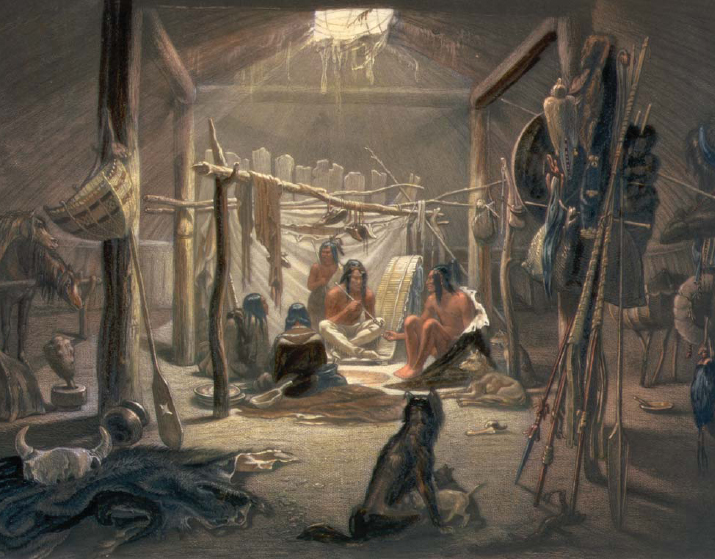
The interior of a Mandan home is shown in this drawing from the 1840s. The Mandan were a tribe of Native Americans that lived on the prairies when the first European settlers arrived in the West.




